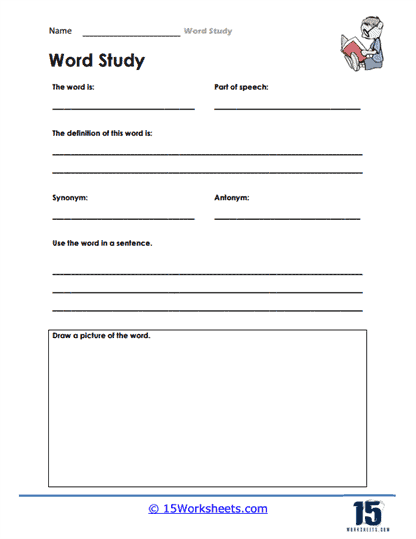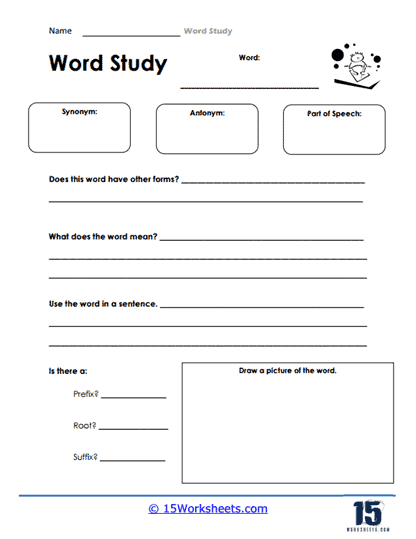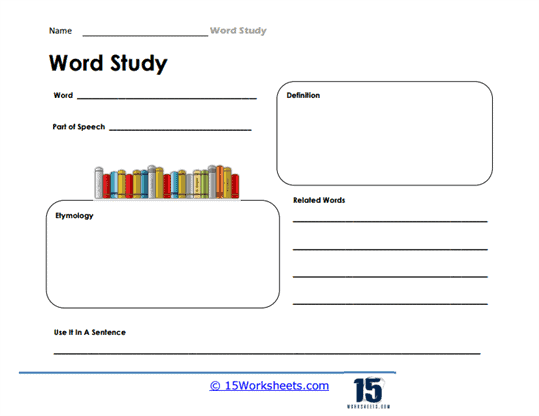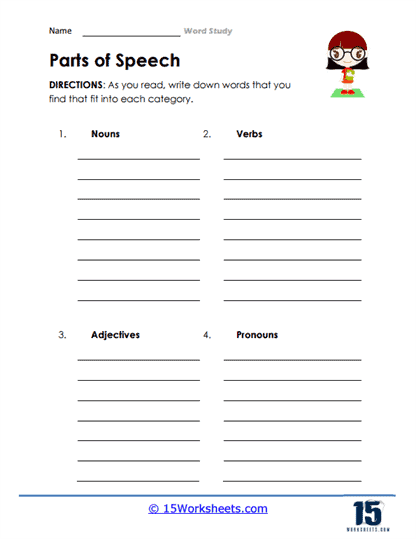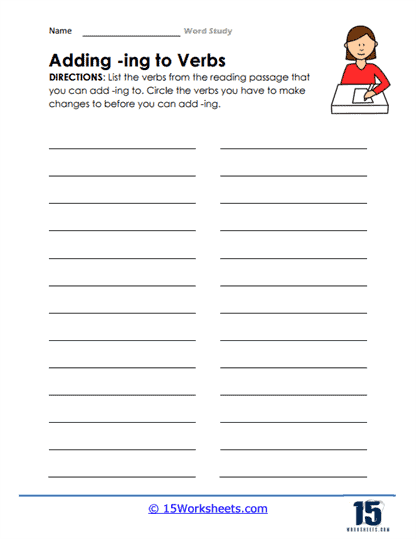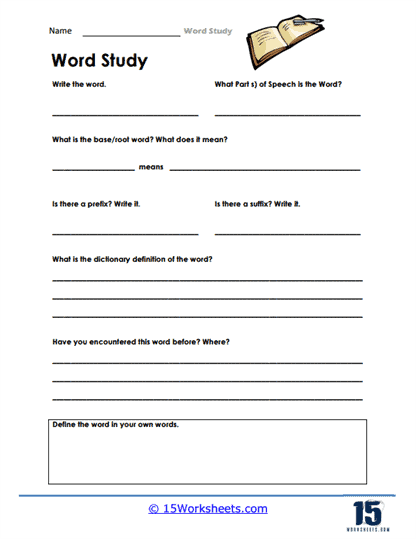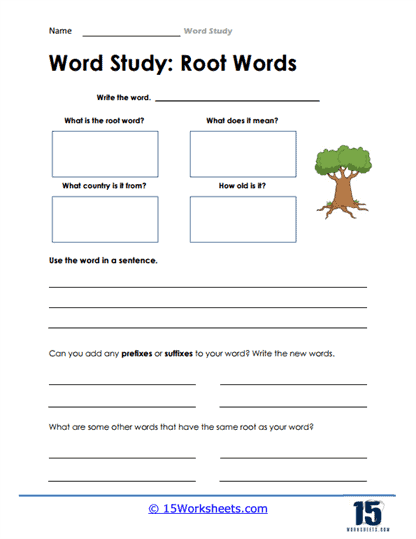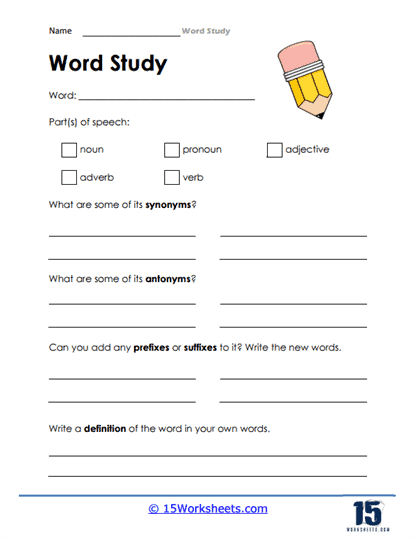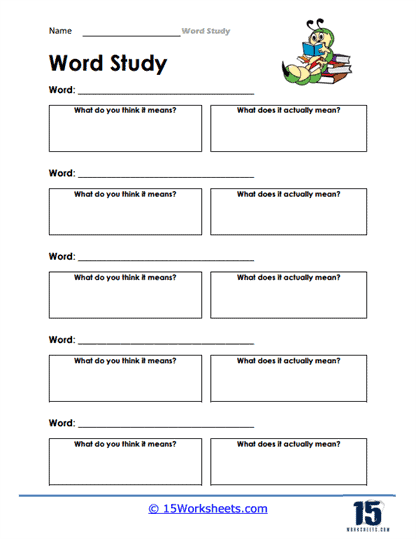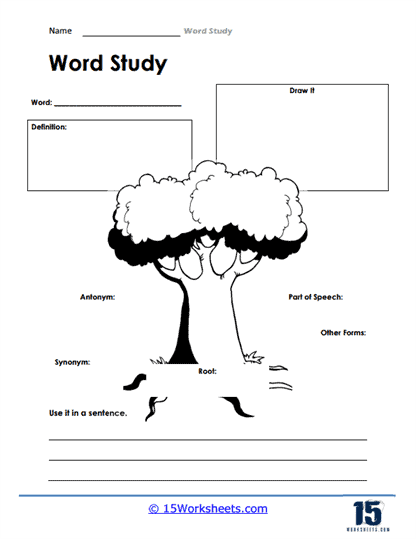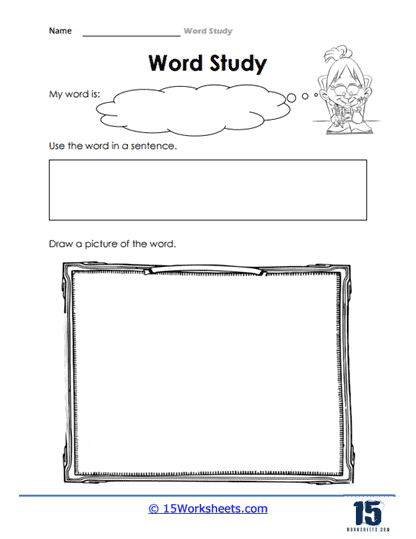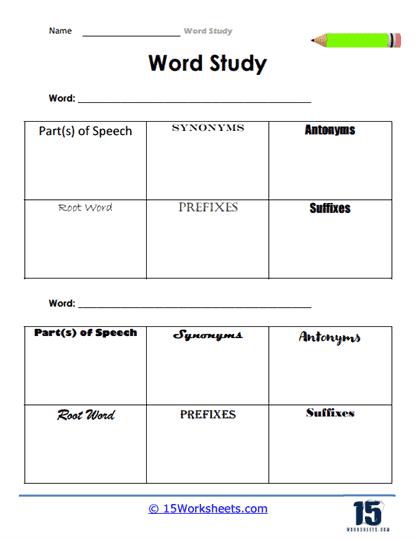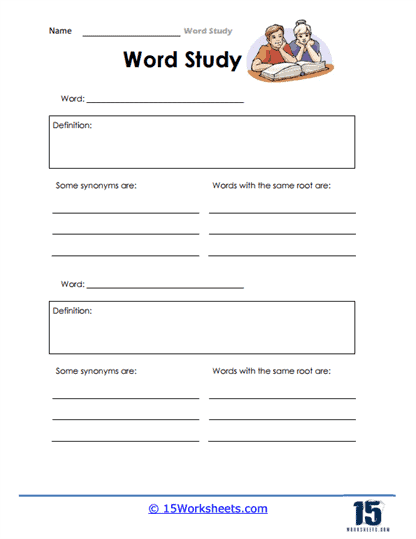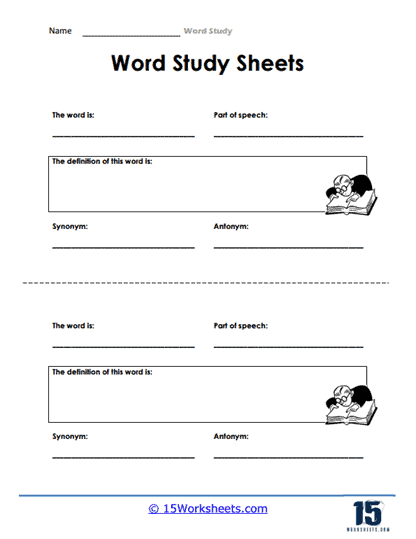Word Study Worksheets
All About These 15 Worksheets
Imagine diving into the world of words like a detective on a mission to crack the code of language. That’s exactly what this set of 15 vocabulary worksheets is all about! Instead of just memorizing words, you’ll be exploring them, breaking them apart, and figuring out how they actually work. It’s like taking a deep dive into the hidden world of words and discovering their secrets – and trust me, it’s way more interesting than you might think.
Each worksheet is packed with activities that aren’t just about spelling and definitions. They push you to really think about words: where they come from, how they connect to other words, and what patterns they follow. And once you start noticing these patterns, you’ll find that spelling and vocabulary become a lot easier (and maybe even fun, dare I say?).
What’s cool is that these worksheets are designed for everyone. No matter what grade you’re in or how strong your vocabulary is right now, there’s something here for you. And because these activities are all about exploring and figuring things out, you get to be in the driver’s seat of your own learning. It’s like being a word scientist, and your lab is every page of this series.
One of the most interesting things you’ll do is explore the roots of words. You’ll discover where words come from (sometimes they’re ancient!) and how they’ve evolved into what we use today. Knowing this kind of stuff not only helps you understand words better but makes you see language as this cool, living thing that’s always changing. Plus, you’ll start recognizing patterns that will help you spell words more easily, even if you’ve never seen them before.
And let’s not forget about how words actually work in real life. Sure, it’s nice to know what a word means, but it’s even better when you know how to use it in everyday conversations, in your writing, or even when you’re decoding tricky terms in school. These worksheets make sure you’re not just learning words for a test, but actually getting better at using them in ways that matter.
The best part? These activities don’t just tell you what to do-they show you how to figure things out for yourself. By the end of this series, you’ll have picked up all kinds of tricks and strategies to help you tackle any new word that comes your way. It’s like building your own toolbox for mastering language, and you’ll be able to keep adding to it long after you’ve finished these worksheets.
For teachers, these worksheets are total game-changers. They go beyond the usual spelling drills and memorization by helping you understand the why behind words. And that makes learning so much more engaging (and a lot less boring). Plus, it’s a resource that you can keep using, growing, and applying to new challenges as you go.
What Is Word Study In English Grammar?
Word study is a method of teaching spelling that is less concerned with memorizing. The method is based on what scholars have learned about English orthography’s alphabet, pattern, and semantic levels. To assist students actively investigate various levels of knowledge, teachers employ a range of hands-on exercises, commonly referred to as word work.
Students investigate the link between letters and sounds when studying the alphabetic layer. They learn to match single letters and pairs of letters (for example, ch) to certain sounds and generate words as a result. When students examine the pattern layer, they seek for bigger patterns that influence the grouping of letters rather than just single or paired letter-sounds (e.g., CVCe).
Students can learn how the English spelling system can directly represent semantic ties between related words by studying the meaning layer. Because compose is connected to the second vowel, pupils learn that the second vowel is spelled with an o when dealing with composition.
Students may see the distinctive patterns in English words by looking at each layer of the orthography – how words operate in our writing system. Word study also teaches students how to apply their word knowledge strategically to assist them interpret unknown words when reading and to enhance their spelling during writing activities. The fundamental purpose of word study is to help students get a working understanding of orthography.
Activities Related to Word Study
Students are given word sorts and challenged to actively learn by making comparisons, drawing conclusions, and manipulating the words into other categories. They are taught to make use of and apply the concept of generalizations when reading and writing.
Giving students all the answers takes away their chance to develop a sense of agency and independence if they have the ability to find things on their own.
The Role of Word Patterns
The word patterns used in word study are selected with the child’s spelling progress in mind. It is a key distinction from conventional approaches to spelling. This indicates that long vowel patterns are the ones the child should focus on learning if they are at the appropriate developmental stage.
Differentiation
True word study also relies heavily on differentiation. In word study courses, students take a spelling inventory to gauge their current level of phonics and word pattern knowledge. The inventory includes different words that gradually rise in complexity to gauge whether or not a student has mastered sound patterns and can accurately express sounds they hear through spelling.
The test results are used to place the students in appropriate classes for their age and stage of development. For instance, students who don’t demonstrate a firm grasp of long vowel patterns won’t move on to investigating how prefixes and suffixes affect a word’s meaning in the context of word study.
Word Sorting
It is common for students to practice word study by sorting words on word cards physically, putting them into categories based on their spelling patterns and sounds. The next step is to record their word sorting on paper. The process encourages them to conceptualize the functionality of the words.
Different Strategies for Word Study Strategy
Teachers play a crucial role in shaping how students interact with and understand language. One powerful tool in this endeavor is a well-structured word study strategy, designed to engage students in exploring the intricacies of vocabulary. When implemented thoughtfully, word study not only enhances spelling and comprehension but also promotes deep connections between words and their meanings. It shifts the focus from rote memorization to understanding patterns, meanings, and relationships. In this expanded discussion, we will delve into a variety of strategies to make word study more dynamic and impactful for students.
The Power of Word Sorting
One of the most common and effective strategies teachers encourage is word sorting. This activity requires students to categorize words based on shared features, such as spelling patterns, prefixes, suffixes, or meanings. Word sorting prompts students to think critically and make connections between seemingly unrelated terms, sharpening their vocabulary skills. For example, a sort might ask students to group words by vowel sounds or by common prefixes like “un-” or “re-.”
However, word sorting goes far beyond a simple categorization exercise. It serves as a gateway to deeper understanding. When students actively analyze word structures, they begin to recognize consistent patterns, which helps them when they encounter unfamiliar words. Word sorting becomes not just a mechanical task but an engaging intellectual exercise that encourages students to reason through the language they use daily. It’s like solving a puzzle-each word fits into a broader system that students are learning to decipher.
Applying Word Knowledge in Context
To solidify the skills learned through word sorting, it’s essential to connect these patterns to real-life applications. One of the most effective ways to do this is by encouraging students to actively seek out the words they are studying in their everyday reading and writing. For instance, if the focus is on words with a particular vowel pattern, students can be challenged to identify examples in their favorite books or classroom texts. This active search turns students into word detectives, sharpening their awareness of how patterns appear in various contexts. It also demonstrates that the study of vocabulary is not an isolated classroom exercise but a skill that enhances all areas of language learning.
Writing assignments also provide an excellent opportunity for applying word knowledge. When students use newly learned vocabulary in their writing, they reinforce their understanding and begin to internalize the word patterns. Teachers can guide students in this process by providing prompts that naturally invite the use of specific types of words or by encouraging students to integrate these words into creative stories or personal reflections. This makes the learning feel authentic and rooted in self-expression.
Creating a Word Wall
Another highly effective strategy for word study is the creation of a word wall. A word wall serves as both a visual aid and a constant reminder of the various word patterns and concepts being studied in the classroom. Words can be categorized by theme, spelling pattern, or linguistic structure and placed prominently in the room for all to see. This communal resource allows students to reference the wall as they work on assignments or read independently, offering a quick and accessible reinforcement of the patterns they are learning.
But a word wall is more than a static list of words-it is a living, breathing element of the classroom. Teachers can encourage students to take ownership of the wall by contributing words they encounter during reading or by leading discussions about the relationships between different words. As the wall grows, so too does the students’ understanding of how words are interconnected. This strategy transforms word study into a collaborative, interactive experience, where students not only learn from their teacher but from each other.
Keeping a Word Study Notebook
Alongside the communal word wall, a personal word study notebook can be an invaluable tool for students to track their own growth and understanding. In this notebook, students can document the patterns they have learned, record words that follow those patterns, and reflect on their personal discoveries about language. This notebook becomes a personalized resource-a place where students can organize their knowledge and revisit it whenever they need reinforcement.
By keeping a word study notebook, students are not merely passive recipients of vocabulary lessons; they are active participants in constructing their own knowledge. They can jot down questions, write examples of words that break the pattern, or make connections to other subjects, such as science or social studies, where specific terminology might follow the patterns they are studying. This process of reflection is key to fostering long-term retention of vocabulary and spelling rules, as it encourages students to engage deeply with the material.
Games and Activities
Engagement is crucial to effective learning, and one of the best ways to keep students invested in their word study is by incorporating games and interactive activities. Word games like Scrabble, Boggle, or Hangman allow students to practice vocabulary in a playful, low-pressure environment. These activities transform the often-monotonous task of memorizing words into a fun challenge, encouraging students to experiment with language and test their knowledge of word patterns.
Teachers can create custom games tailored to the words and patterns being studied in class. For example, a game might involve students racing to find and sort words from a list or completing a crossword puzzle where all the clues relate to a specific spelling rule. By turning word study into a game, students often become more eager to participate and retain the knowledge they gain through play.
Word study should be more than an isolated part of the curriculum; it should be a living, dynamic process that students carry with them throughout their academic journey and beyond. When implemented thoughtfully, word study helps students become better readers, stronger writers, and more confident communicators, equipped with the tools to navigate the vast and intricate world of language.

